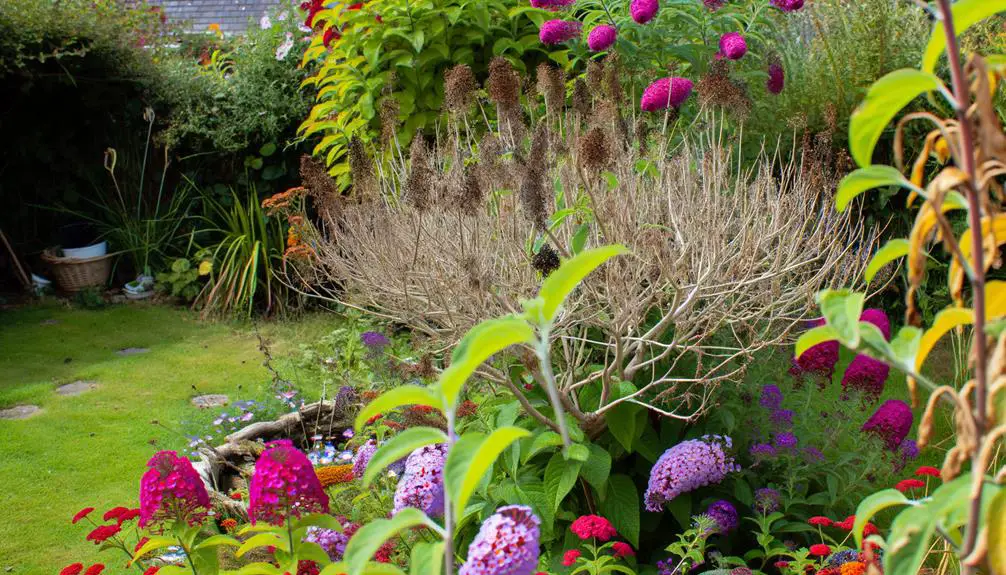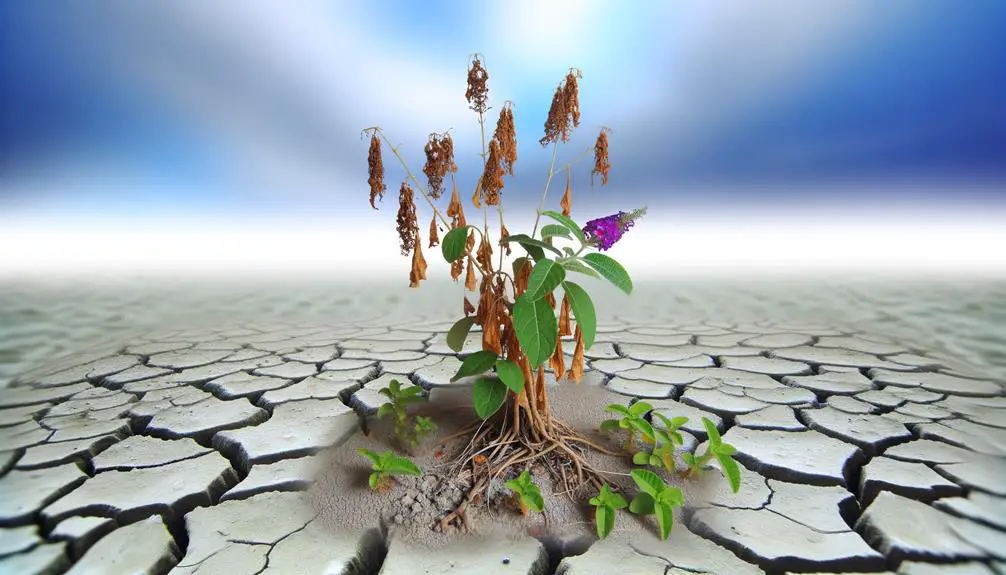Why Is My Butterfly Bush Not Blooming This Season?
A butterfly bush's failure to bloom can be due to various factors, such as improper pruning techniques that disrupt bud formation or insufficient sunlight, which hinders photosynthesis. Poor soil quality and nutrient imbalances can stifle growth, while inadequate or excessive watering can cause water stress or root diseases.
Pests and diseases also play an essential role by weakening the plant. Planting depth and spacing directly affect root oxygenation and nutrient uptake.
Finally, extreme climate conditions and overcrowding can lead to competitive stress. Understanding these detailed observations and scientific reasoning will help in diagnosing and resolving blooming issues.

Key Takeaways
- Incorrect pruning in late spring or summer removes developing flower buds, disrupting the blooming cycle.
- Insufficient sunlight, less than six hours daily, affects photosynthesis and stunts flower development.
- Poor soil quality or nutrient deficiencies, especially in nitrogen, phosphorus, and potassium, impede floral growth.
- Imbalanced watering, either overwatering or underwatering, causes stress and affects nutrient transport and root health.
Incorrect Pruning Techniques

Improper pruning techniques can greatly affect the blooming cycle of the butterfly bush (Buddleja spp.), as it disrupts the plant's natural growth and flowering patterns.
Pruning at the wrong time, particularly during late spring or summer, can remove developing flower buds, thereby inhibiting bloom production. In addition, excessive pruning can lead to reduced photosynthetic capacity, as fewer leaves are available to capture sunlight and generate energy.
Conversely, insufficient pruning can result in overcrowded branches, which diminishes air circulation and light penetration, causing stress that further impedes flowering.
Ideal pruning should be performed in late winter or early spring, before new growth initiates, to guarantee robust bud formation and maximize the plant's blooming potential.
Insufficient Sunlight
Another essential factor that can hinder the blooming of butterfly bushes is insufficient sunlight, as these plants require a minimum of six hours of direct sunlight each day to thrive and produce flowers effectively.
Photoperiodism, the physiological reaction of organisms to the length of day or night, plays a significant role in the blooming process. Insufficient sunlight disrupts photosynthetic rates, reducing energy availability for flower production.
Observational studies indicate that butterfly bushes positioned in partial shade exhibit stunted growth and diminished flowering. The chlorophyll content diminishes, impairing the plant's ability to convert light energy into chemical energy.
As a result, ensuring ideal sunlight exposure is paramount for maintaining the photosynthetic efficiency and overall health of butterfly bushes, thus promoting robust blooming.
Poor Soil Quality

Poor soil quality can greatly impede the blooming of butterfly bushes by restricting root growth and nutrient uptake, thereby stunting overall plant development. Less than ideal soil parameters can lead to several issues:
- Nutrient Deficiency: Essential macronutrients such as nitrogen, phosphorus, and potassium are vital for floral development and overall plant health.
- Poor Drainage: Waterlogged conditions can lead to root rot, causing the roots to be inefficient in nutrient absorption.
Addressing soil quality involves conducting a soil test to determine nutrient levels and pH balance.
Amending the soil with organic matter, such as compost, can improve its structure, fertility, and drainage capabilities, fostering ideal conditions for blooming.
Watering Issues
Inadequate watering practices can greatly hinder the blooming of butterfly bushes by either causing water stress or promoting root diseases.
Insufficient watering can lead to dehydration, inhibiting the plant's ability to transport essential nutrients and triggering stress responses that curtail flowering.
Conversely, overwatering can create waterlogged conditions, fostering an anaerobic environment conducive to root rot and fungal infections. These pathogenic conditions disrupt the plant's physiological processes, impairing nutrient uptake and reducing overall vigor.
For ideal blooming, it is critical to maintain a balance: well-draining soil that remains consistently moist but not saturated.
Employing a mulch layer can help regulate soil moisture levels, mitigating evaporation and ensuring a stable environment for root growth and flower development.
Nutrient Deficiencies

Nutrient deficiencies can greatly impede the blooming of a butterfly bush, with soil nutrient imbalances often being a primary concern.
A lack of essential nutrients such as nitrogen, phosphorus, and potassium can result from insufficient fertilization practices.
Regular soil testing and appropriate fertilization are essential to guarantee the plant receives adequate nutrition for ideal flowering.
Soil Nutrient Imbalance
A significant factor contributing to the lack of blooming in butterfly bushes is an imbalance in soil nutrients, particularly deficiencies in essential elements such as phosphorus and potassium.
Phosphorus is critical for flower development, while potassium enhances overall plant health and resilience. An imbalance in these nutrients can be diagnosed through detailed soil testing and analysis.
Notable symptoms of nutrient deficiencies include:
- Poor flower formation: Indicating a lack of phosphorus, essential for blooming.
- Weak stems and leaves: Suggesting insufficient potassium, crucial for plant vigor.
Rectifying these deficiencies through targeted soil amendments can restore the nutrient balance, promoting healthy blooming and robust growth in butterfly bushes.
Lack of Fertilization
While soil nutrient imbalances can markedly impede blooming, another essential factor is the lack of adequate fertilization, which directly contributes to nutrient deficiencies in butterfly bushes.
Crucial nutrients such as nitrogen, phosphorus, and potassium are necessary for their ideal growth and flowering. Insufficient fertilization can lead to poor root development, reduced chlorophyll production, and stunted growth, ultimately hindering the plant's ability to produce blooms.
Observations indicate that a balanced, slow-release fertilizer, applied in early spring and mid-summer, can rectify these deficiencies. The scientific reasoning behind this approach lies in ensuring a steady nutrient supply, thereby promoting robust flowering.
Regular soil testing is advised to ascertain specific nutrient needs, allowing for precise and effective fertilization strategies.
Pest Infestation
Pest infestation is a significant factor that can inhibit the blooming of butterfly bushes, often resulting in weakened plants and reduced flower production. Numerous pests can affect butterfly bushes, leading to the diversion of the plant's resources from flower development to pest resistance and survival.
Key pests include:
- Aphids: These sap-sucking insects can cause stunted growth and reduced blooming by extracting essential nutrients.
- Spider Mites: Infestations result in leaf stippling, chlorosis, and eventual defoliation, impacting photosynthesis and overall vigor.
Effective pest management through vigilant monitoring and timely interventions is essential for maintaining the health and flowering potential of butterfly bushes.
Disease Problems
Disease problems can greatly impact the blooming of butterfly bushes.
Fungal infections often lead to stunted growth and reduced flower production.
Viral diseases may cause deformed blooms or complete absence of flowering due to systemic infection.
Additionally, bacterial issues in the soil can impair root function and nutrient uptake, further inhibiting the plant's ability to produce healthy blooms.
Fungal Infections Impacting Growth
Fungal infections, such as Botrytis cinerea and powdery mildew, can greatly impede the blooming of butterfly bushes by disrupting essential physiological processes. These pathogens interfere with photosynthesis, nutrient uptake, and overall plant vigor, leading to suboptimal blooming conditions.
Botrytis cinerea: This grey mold infects flowers and leaves, causing tissue decay and hindering bud development.
Powdery mildew: Characterized by white, powdery fungal growth on leaves, this disease restricts photosynthetic efficiency and weakens the plant.
Root rot: Often caused by Phytophthora species, this infection impairs root function, leading to poor nutrient and water absorption, consequently stunting growth and bloom production.
Viral Diseases Affecting Blooms
Several viral pathogens, including the Tomato spotted wilt virus (TSWV) and Cucumber mosaic virus (CMV), can severely impair the blooming potential of butterfly bushes by disrupting cellular processes and hindering normal growth patterns. These viruses alter the plant's physiological functions, causing symptoms such as chlorosis, mosaic patterns on leaves, and stunted growth, all of which contribute to a reduction in floral development.
| Virus | Symptom |
|---|---|
| TSWV | Chlorosis, necrotic spots |
| CMV | Mosaic leaf patterns |
| Mixed Infections | Severe stunting, leaf distortion |
Scientific observations indicate that viral infections compromise the plant's vascular system, limiting nutrient and water transport. This disruption is critical as it directly impacts the plant's ability to support bloom formation, thereby diminishing the overall aesthetic and ecological value of the butterfly bush.
Bacterial Issues in Soil
Bacterial pathogens present in the soil, such as Ralstonia solanacearum and Agrobacterium tumefaciens, can considerably impede the blooming of butterfly bushes by causing root and vascular system damage.
These pathogens disrupt the plant's ability to absorb water and nutrients, essential for bud formation and flowering. Observations indicate that infected plants exhibit symptoms such as wilting, stunted growth, and eventual decline.
Key impacts of bacterial soil pathogens include:
- Root Rot: Degradation of root integrity, hampering nutrient uptake.
- Vascular Blockage: Obstruction of xylem vessels, restricting water flow.
Mitigation strategies involve improving soil drainage, employing resistant cultivars, and utilizing bactericidal soil treatments to manage and prevent bacterial infections.
Improper Planting Depth
Improper planting depth can greatly impact the blooming potential of butterfly bushes by affecting root establishment and nutrient absorption.
When planted too deeply, the roots may struggle to access adequate oxygen, resulting in poor root development and reduced vigor. Conversely, planting too shallowly can expose roots to extreme temperature fluctuations and desiccation, inhibiting their ability to uptake essential nutrients and water.
Precise planting at the correct depth guarantees that the root crown is level with the soil surface, facilitating ideal gas exchange and nutrient uptake. Proper depth also mitigates stress factors such as root rot and fungal infections, which can further impede blooming.
Attention to planting depth is therefore essential for maximizing the floriferous potential of butterfly bushes.
Climate and Weather Factors

While proper planting depth is essential for root health, the success of butterfly bush blooming is also greatly influenced by climate and weather conditions.
Butterfly bushes, or *Buddleja davidii*, thrive in specific environmental parameters. Inadequate blooming may result from: nutrient deficiencies, improper pruning, or insufficient sunlight. These shrubs require well-drained soil and at least six hours of direct sunlight daily to produce vibrant blooms. Gardeners who enjoy cultivating butterfly bushes may also appreciate exploring floral infusions, such as discovering the unique butterfly pea tea taste.
- Temperature Extremes: Consistent temperatures below 40°F or above 95°F can inhibit bud formation and flowering.
- Rainfall Variability: Insufficient or excessive rainfall disrupts the plant's water balance, leading to stress and reduced blooming.
Understanding these climatic factors is pivotal for diagnosing and remedying poor flowering in your butterfly bush. Ideal conditions are critical for ensuring vibrant and sustained blooms.
Overcrowding in the Garden
Overcrowding in the garden can lead to competition for essential resources such as light, water, and nutrients, greatly impairing the blooming potential of butterfly bushes. When plants are spaced too closely, they vie for sunlight, which can result in less than ideal photosynthesis rates, thereby inhibiting floral development.
Additionally, overcrowded root systems struggle to absorb sufficient water and nutrients from the soil, compromising plant health. Scientific studies have shown that reduced soil aeration and increased pathogen transmission are common in densely planted areas, further stressing the plants.
To enhance blooming, it is vital to guarantee adequate spacing, typically 3-5 feet depending on the butterfly bush variety, to facilitate ideal light penetration, root expansion, and air circulation, thereby promoting robust flowering.
Conclusion
To sum up, the impediments to the blooming of Buddleja davidii often stem from factors such as incorrect pruning techniques, insufficient sunlight, poor soil quality, watering issues, nutrient deficiencies, disease problems, improper planting depth, climate and weather factors, and overcrowding in the garden.
Like the mythological Sisyphus, gardeners may find themselves repeatedly addressing these challenges.
However, through meticulous attention to horticultural best practices, ideal blooming conditions can be achieved, therefore ensuring the butterfly bush flourishes with its characteristic splendor.






